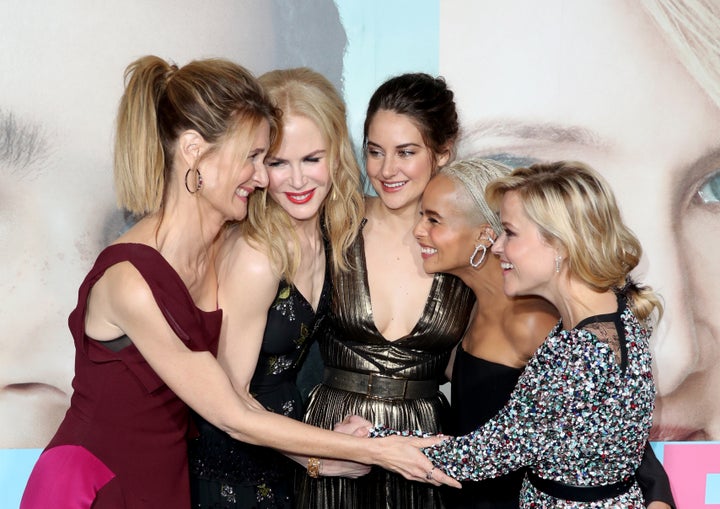
The last 15 minutes of the finale of “Big Little Lies” contains very few words. We find out the answers to three long-unanswered questions through images: Who was murdered? Who killed that person? And who is the man who brutally assaulted Jane Chapman and fathered her son, Ziggy?
That third question ends up being the most salient one. And the scene that gives us its answer epitomizes what is so stunning about the HBO mini-series: At its core, “Big Little Lies” is about the deep, complex and protective connections that can form between women in the face of buried trauma.
A testament both to the direction by Jean Marc-Vallée and the stellar acting by Reese Witherspoon as Madeline, Nicole Kidman as Celeste, and Shailene Woodley as Jane, in the finale’s climactic scene, words become unnecessary.
As Jane realizes that the man who has been tormenting her thoughts for six years is Celeste’s outwardly charming and inwardly abusive husband Perry, we see this realization be passed along through a grip and two looks ― first to Madeline and then to Celeste. Women who spend time together and form an intimacy often develop the ability to silently communicate warnings ― something I have never before seen expressed so pointedly on television.
As the New Yorker’s Jia Tolentino put it: “The show understands that minor social transactions between women can express the nuances of violence with a unique specificity and a nauseating subtlety.”
The searing portrayal of these sort of “minor social transactions between women” ― in the context of violence and outside of it ― are what make “Big Little Lies” so affecting. We see them play out in many varying configurations over the course of the seven episodes: between Madeline and her daughter, between Celeste and her therapist (Robin Weigart), between Renata (a fantastic Laura Dern) and Jane, between Renata and Celeste, between Bonnie (Zoe Kravitz) and Madeline, and between Jane, Madeline and Celeste.
“Big Little Lies” artfully digs into the systemic pressures women face ― to be perfect parents, perfect wives and perfect models of femininity ― even when they are white and wealthy with the best beachfront properties California has to offer. The show easily passes the Bechdel test as we watch these women discuss parenting, sexual fulfillment (or a lack thereof), professional fulfillment (or a lack thereof), sexual assault, therapy and the deep well of unhappiness that often lurks underneath a veneer of “perfection.”
Although the show was directed by Marc-Vallée and written by David E. Kelley, the depth of female interaction present in “Big Little Lies” makes it unsurprising that the original novel was written by a woman, and that the project got off the ground thanks to Reese Witherspoon and Nicole Kidman’s respective production companies. (Witherspoon and her producing partner originally optioned Liane Moriarty’s novel, and then brought Kidman on board.) This is especially important given that the directors, showrunners and producers of both TV series and movies remain overwhelmingly white and male.
“For 25 years, I’ve been the only woman on set,” Witherspoon told The Hollywood Reporter back in January, when talking about what drew her to “Big Little Lies.” “So I had no one to talk to... We have to start seeing women how they actually are on film ― we need to see real women’s experience ― whether that involves domestic violence, sexual assault, romance, infidelity or divorce. We as human beings learn from art.”

This show didn’t necessarily speak to all men, judging from the tepid and misguided reviews written by some male critics.
Mike Hale at the New York Times called the female-driven storylines at the center of “Big Little Lies” unoriginal and “just a compendium of clichés,” even comparing the nuanced portrayal of an abusive relationship between Kidman’s Celeste and Alexander Skarsgard’s Perry to “’Fifty Shades’ territory.” The New York Post’s Robert Rorke, who also flippantly referred to the abusive relationship as “S&M games,” called the show “a terrible whodunnit” about “rich white women and their erotic fantasies and emotional dissatisfactions.”
Both Hale and Rorke appeared frustrated that they were sold a murder mystery, and then ended up having to listen to women talk about their lives, desires and feelings. This frustration, while easy to skewer, also reflects a depressing truth. Because the stories of white men still tend to appear in pop culture most often and with greater nuance, women and people of color learn to find some piece of themselves in cultural products that are not about them. White men are not faced with that same imperative.
Luckily, the buy-in of curmudgeonly white men who don’t see value in unpacking women’s stories is no longer necessary for a series to be a critical or ratings hit.
In the final moments of “Big Little Lies,” we see our five female leads together on the beach, at last standing in solidarity and connected by a shared trauma. Sometimes, on TV as in life, women are enough to carry each other through.
